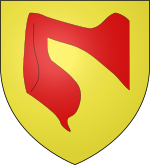Baron Hastings
| Baron Hastings | |
|---|---|

Arms of John de Hastings: Or, a maunch gules, from the Collins Roll, also appears in the Dering Roll, A217; The Caerlaverock Poem, K83; St George's Roll, E119 & The Galloway Roll, GA223
|
|
| Peerage | Peerage of England |
Baron Hastings is a title that has been created three times. The first creation was in the Peerage of England in 1295, and is extant. The second creation was in the Peerage of England in 1299, and became extinct on the death of the first holder in c. 1314. The third creation was in the Peerage of England in 1461, and has been in abeyance since 1960.
John Hastings was summoned to the Model Parliament as Lord Hastings on 23 June 1295. He was the son of Henry de Hastings, who had been created Baron Hastings by Simon de Montfort in 1263. Since the first Baron's title does not appear to have been recognised by the King, although his son John Hastings is sometimes referred to as the second Baron Hastings, the majority of historians enumerate John as 1st Baron Hastings. John Hastings's grandson, the third Baron Hastings, was created Laurence Hastings, 1st Earl of Pembroke in 1339. The latter’s son, the second Earl of Pembroke, married as his second wife Anne Hastings, 2nd Baroness Manny. Their son, the third Earl and fifth Baron Hastings, succeeded his mother as third Baron Manny.
On his death in 1389 the earldom and barony of Manny became extinct, while the barony of Hastings became dormant. It then became the subject of a bitter-fought lawsuit, nominally over the right to the Hastings arms but including the right to the family honours. The barony was claimed by Hugh Hastings (1377–1396) (later deemed the de jure 7th Baron Hastings; see below). He was the eldest son of Sir Hugh Hastings, grandson of Sir Hugh Hastings (c. 1307–1347), son of the second Baron by his second wife. Hugh claimed the title as "heir of the half blood". However, the claim was contested by Reginald Grey, 3rd Baron Grey de Ruthyn, as "heir of the whole blood". Lord Grey de Ruthyn claimed the Barony in right of his grandmother Elizabeth, daughter of the second Baron Hastings by his first wife. On the early death of Hugh Hastings in 1396 the claim passed to his younger brother Edward Hastings (1382–1438) (later deemed the de jure 8th Baron Hastings; see below). In 1410 a court decided in favour of Grey. Hastings immediately appealed, and at the coronation of Henry V in 1413, he claimed the right to carry the spurs before the King, which Lord Grey de Ruthyn had done undisputed in 1399 at the coronation of Henry IV. Hastings was later ordered to pay the costs of the trial. When he refused, he was imprisoned in 1417. He remained imprisoned until 1433, but refused to buy his release by abandoning his claims. No final decision regarding the Barony was made at the time, but both families continued to claim the title. The Greys finally abandoned their claim in 1639.
...
Wikipedia
